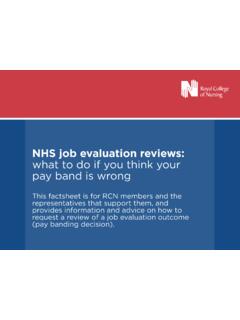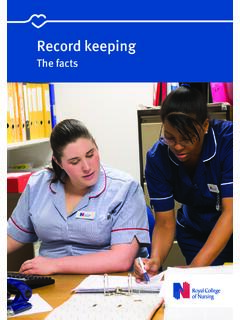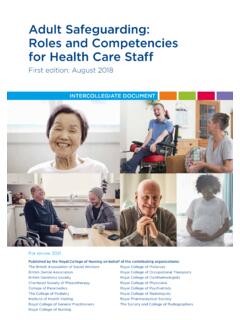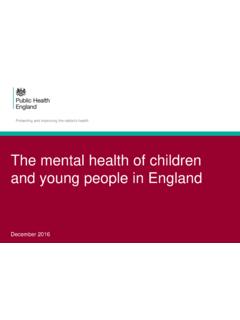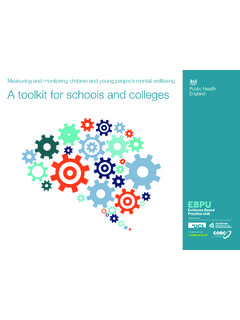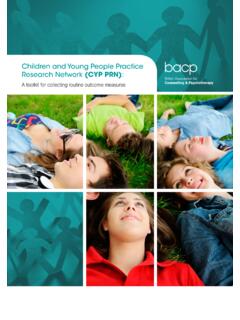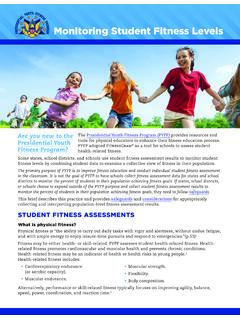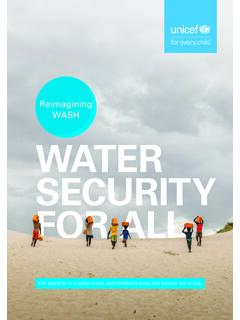Transcription of Standards for Assessing, Measuring and Monitoring Vital ...
1 CLINICAL PROFESSIONAL RESOURCES tandards for assessing , Measuring and Monitoring Vital Signs in Infants, children and young People2 PublicationThis is an RCN practice guidance. Practice guidance are evidence-based consensus documents, used to guide decisions about appropriate care of an individual, family or population in a specific Monitoring and measurement of Vital signs and clinical assessment are core essential skills for all health care practitioners working with infants, children and young people . This guidance applies to professionals who work in acute care settings, as well as those who work in GP surgeries, walk-in clinics, telephone advice and triage services, schools and other community settings.
2 Publication date: May 2017 Review date: May 2020 The Nine Quality StandardsThis publication has met the nine quality Standards of the quality framework for RCN professional publications. For more information, or to request further details on how the nine quality Standards have been met in relation to this particular professional publication, please contact EvaluationThe authors would value any feedback you have about this publication. Please contact clearly stating which publication you are commenting Legal DisclaimerThis publication contains information, advice and guidance to help members of the RCN.
3 It is intended for use within the UK but readers are advised that practices may vary in each country and outside the UK. The information in this booklet has been compiled from professional sources, but its accuracy is not guaranteed. Whilst every effort has been made to ensure the RCN provides accurate and expert information and guidance, it is impossible to predict all the circumstances in which it may be used. Accordingly, the RCN shall not be liable to any person or entity with respect to any loss or damage caused or alleged to be caused directly or indirectly by what is contained in or left out of this website information and by the Royal College of Nursing, 20 Cavendish Square, London, W1G 0RN 2017 Royal College of Nursing.
4 All rights reserved. No part of this publication may be reproduced, stored in a retrieval system, or transmitted in any form or by any means electronic, mechanical, photocopying, recording or otherwise, without prior permission of the Publishers. This publication may not be lent, resold, hired out or otherwise disposed of by ways of trade in any form of binding or cover other than that in which it is published, without the prior consent of the publication is due for review in May 2020. To provide feedback on its contents or on your experience of using the publication, please email RCN would like to thank everyone who contributed to earlier editions, and to those who provided expertise and guidance to develop the Standards contained in this edition, particularly.
5 Coral ReesAdvanced Paediatric Nurse Practitioner, Noah s Ark children s Hospital for WalesSarah NeillAssociate Professor in children s Nursing,University of NorthamptonDoreen Crawford Senior Lecturer, De Montfort UniversityNurse advisor for an Independent Healthcare ConsultancyConsultant Editor Nursing children and young people JournalRachael Bolland Nurse Consultant Acute Paediatrics,St George s University Hospitals NHS Foundation Trust Senior Lecturer, children s Nursing, London South Bank UniversityGerri Sefton Advanced Nurse Practitioner PICU,Alder Hey children s NHS Foundation TrustLead for Paediatric Early Warning System Peter-Marc FortuneConsultant Paediatric Intensivist,Associate Clinical HeadRoyal Manchester children s HospitalROYAL COLLEGE OF NURSING31.
6 Introduction 42. Education and training 73. Teaching children , young people and parents/carers 84. assessing and Measuring Vital signs 95. Record keeping 176. Medical devices and equipment 18 Appendix 1: APLS normal values 19 Additional resources 20 References 21 ContentsSTANDARDS FOR assessing , Measuring AND Monitoring Vital SIGNS41. IntroductionThe Monitoring and measurement of Vital signs and clinical assessment are core essential skills for all health care practitioners working with infants, children and young people (Cook and Montgomery 2010). This guidance applies to professionals who work in acute care settings, as well as those who work in GP surgeries, walk-in clinics, telephone advice and triage services, schools and other community settings.
7 Vital signs assessment takes place as part of the art of observation and Monitoring of the infant, child or young person. The term assessment describes the broader process involving visual observation, palpation (touch), listening and communication to evaluate the infant, child or young person s condition. Assessment can include the characteristics, interactions, non-verbal communication, and reaction to physical surroundings that infants, children or young people may display (Aylott, 2006).The Vital signs included in this document are heart/pulse rate, respiratory rate and effort, blood pressure, oxygen saturations, capillary refill time, level of consciousness and temperature.
8 Weight, height and pain assessment will also be discussed. The following document describes Standards , based on current evidence, best practice and expert aim of observing and Monitoring infants, children and young people fulfils many functions:1) To provide a baseline of normal Vital signs for well children attending for a procedure or surgical intervention, so that their health status can be re-evaluated later following the procedure. 2) To provide a baseline of the sick child s physiological state at presentation to hospitals or health care settings. NB: This is not the child s baseline normal physiological state but can contribute to trend analysis of a child s illness.
9 3) To demonstrate a rigorous assessment of physiological state is made eg, at admission to hospital or when there is concern that there is deterioration in a child s condition: to assist in making a diagnosis to contribute to consideration of differential diagnoses to judge how unwell a child is, or whether they are in compensated or decompensated ) To triage workload and to identify potential children at risk of ) To allow planning to manage and mitigate those ) To monitor an infant or child s COLLEGE OF NURSING5 Paediatric Early Warning Scores (PEWS) The use of a validated Paediatric Early Warning (PEWS)
10 Score may aid individual and team situation awareness of the children at risk of deterioration, particularly for junior staff or those new to caring for infants, children and young people . However, it is acknowledged that PEWS will not identify all children at risk of deterioration, either due to the speed or the mechanism of deterioration. Therefore, it is essential that all clinical staff are trained to recognise common patterns of deterioration with or without the use of a PEWS and not just use the score for reassurance. Other components of a safe system to recognise and respond to children at risk of deterioration include: succinct communication tools to convey critical information eg, SBAR Situation, Background, Assessment and Recommendation (SBAR) tool (NHS Institute for Innovation and Improvement, 2008) a multidisciplinary approach to care (Confidential Enquiry into Maternal and Child Health (CEMACH) 2008, McCabe et al.)





